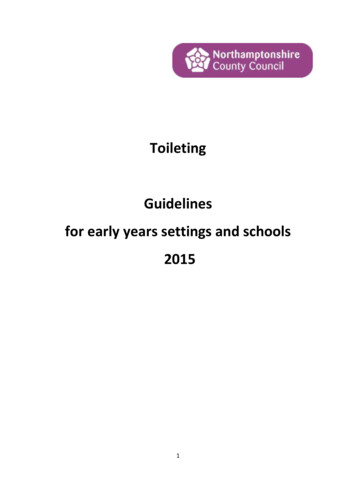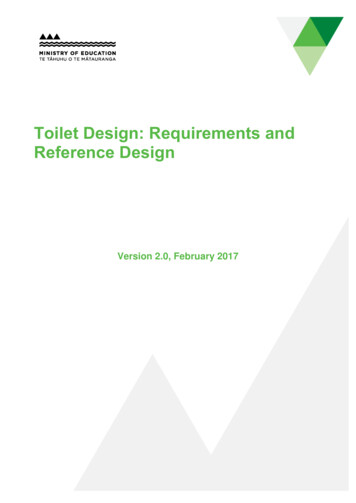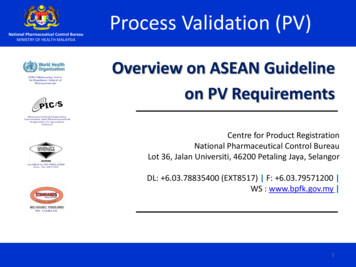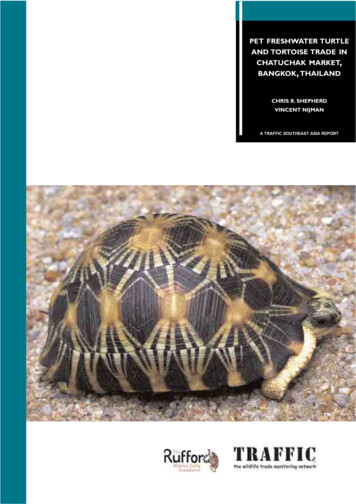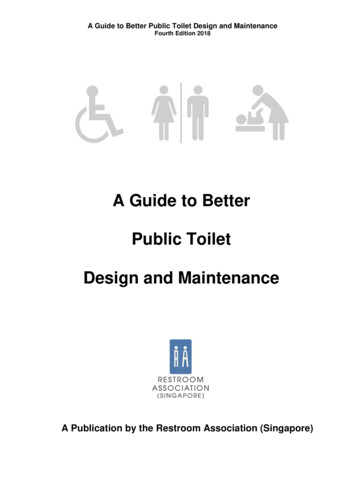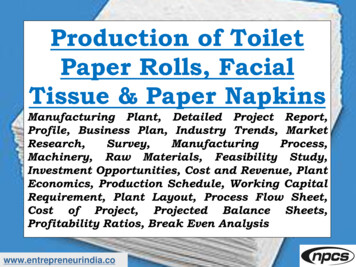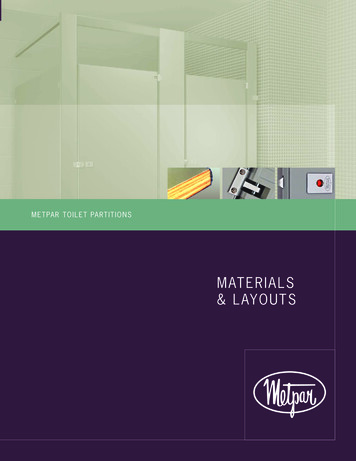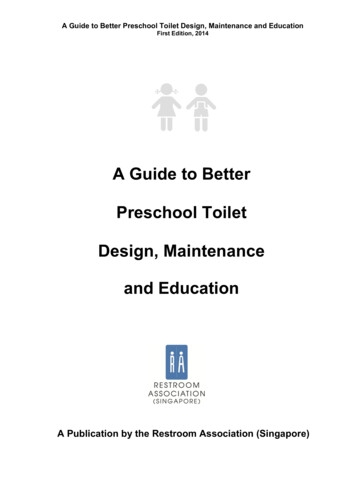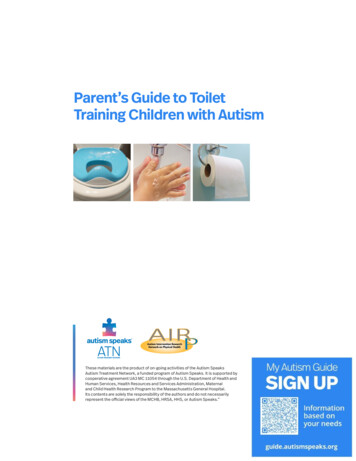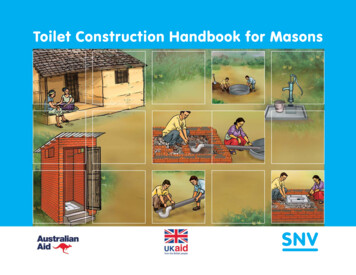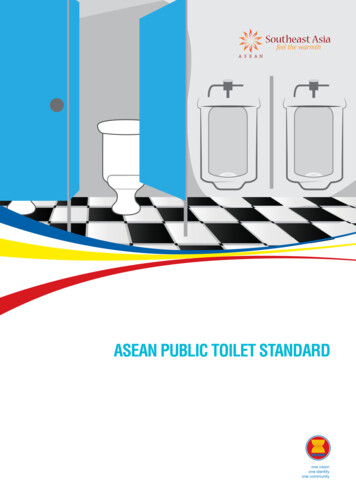
Transcription
ASEAN PUBLIC TOILET STANDARDone visionone identityone community
ASEAN Public Toilet StandardThe ASEAN SecretariatJakarta
The Association of Southeast Asian Nations (ASEAN) was established on 8 August 1967. The Member Statesof the Association are Brunei Darussalam, Cambodia, Indonesia, Lao PDR, Malaysia, Myanmar, Philippines,Singapore, Thailand and Viet Nam. The ASEAN Secretariat is based in Jakarta, Indonesia.For inquiries, contact:The ASEAN SecretariatPublic Outreach and Civil Society Division70A Jalan SisingamangarajaJakarta 12110IndonesiaPhone : (62 21) 724-3372, 726-2991Fax: (62 21) 739-8234, 724-3504E-mail : public@asean.orgCatalogue-in-Publication DataASEAN Public Toilet StandardJakarta: ASEAN Secretariat, January 2016338.47911. ASEAN – Tourism2. Public Toilet – Waste Management – GuidelinesISBN 978-602-0980-76-8General information on ASEAN appears online at the ASEAN Website: www.asean.orgThe text of this publication may be freely quoted or reprinted, provided proper acknowledgement is given anda copy containing the reprinted material is sent to Public Outreach and Civil Society Division of the ASEANSecretariat, JakartaCopyright Association of Southeast Asian Nations (ASEAN) 2016.All rights reserved
ASEAN PUBLIC TOILET STANDARDASEAN Public Toilet Standard3
4ASEAN Public Toilet Standard
INDEXI.1.2.3.4.5.II.1.2.3.4.5.6.ASEAN PUBLIC TOILET STANDARDForewordIntroductionScopeTerms & Definition4.1. Public Toilet4.2. Waste Management4.3. Cubicle4.4. VisitorCriteria5.1. Design and Environmental Management System5.1.1. Good waste water management system and standardizedwater treatment system5.1.2. Pleasant landscape and design5.1.3. Clear public toilet signboards5.1.4. Encourage the appropriate use of the toilet and importance ofhygiene5.1.5. Disabled and elderly facilities5.2. Amenities and facilities5.2.1. Appropriate space for each cubicle5.2.2. Sufficient provision of amenities5.2.3. Coat hangers and ledges in cubicles5.3. Cleanliness5.3.1. Adequate air circulation & ventilation system5.3.2. Good smell and no dirty areas5.3.3. Floors should be kept clean and dry5.3.4. Trained personnel on the facility for cleaning and maintenance5.3.5. Customers’ suggestion box5.3.6. Regular cleaning and maintenance of the toilet premises5.4 Safety5.4.1. Adequate lighting5.4.2. Public location5.4.3. No slippery ground or surface5.4.4. Firm construction5.4.5. Cleaning Agent2233333333333444444ASEAN PUBLIC TOILET STANDARD - AUDIT peImplementationTerms and Definitions6.1. Ambulant6.2. Amenities6.3. ASEAN Context7788899991111122222222ASEAN Public Toilet Standard - Indexi
dit ChecklistBackflowBlindBlind AuditCorrective Action LogCubicleClean, CleanlinessCleaningDisabled populationFittings (a small part on or attached to a piece of furniture or equipment)Fixtures (a piece of equipment or furniture which isfixed in position in a building)6.15. Fixture supply6.16. Inspection Card Toilet6.17. Local government/authority/entity refers6.18. Public Toilet6.19. Reticulated sewerage system refers6.20. Safe, safety6.21. Self Assessment Checklist6.22. Toilet Suggestion Log6.23. Toilet Visitor6.24. Universal Design (UD)6.25. Visually Impaired (of a patient)6.26. Waste Management7. Abbreviations8. Criteria Guideline8.1. Design and Environmental Management System8.2. Amenities and Facilities8.3. Cleanliness8.4. Safety9. Auditing Guideline9.1. How the criteria in the audit are used for Public Toilets assessment9.2. Audit Assessment Methods9.3. Audit Process FlowchartANNEXESAnnex A IllustrationsAnnex B Self-Assessment ChecklistAnnex C Audit Checklist and ReportAnnex D Corrective Remedy PlanReferencesIII.ASEAN PUBLIC TOILET STANDARD - CHECKLIST CRITERIAIV.1.2.3.ASEAN PUBLIC TOILET STANDARD - AUDIT MANUALIntroductionAbbreviationsTerms and Definitions3.1. Ambulant3.2. Amenities3.3. APTS AuditiiASEAN Public Toilet Standard - 313172021232323262935394748575757575858
.25.3.26.4.5.6.7.APTS AuditorsASEAN ContextAudit ChecklistAudit Criteria and RequirementsAudit EvidenceAudit ObjectivesAudit PlanAudit ProceduresAudit ReportAudit ScopeAPTS Standard and APTS Audit Checklist & GuidelineAuditeeBackflowBlindBlind AuditCorrective Action PlanCubicleClean, CleanlinessCleaningDisabled populationFindings, Conclusions and RecommendationsFittings (a small part on or attached to a piece of furniture or equipment)Fixtures (a piece of equipment or furniture which isfixed in position in a building)3.27. Fixture supply3.28. Graffiti3.29. Inspection Card Toilet3.30. Local government/authority/entity3.31. Nonconformity3.32. (Public Toilet) Quality Management System3.33. Public Toilet3.34. Reticulated sewerage system3.35. Safe, safety3.36. Self-Assessment Checklist3.37. Toilet Suggestion Log3.38. Toilet Visitor3.39. Universal Design (UD)3.40. Vandalism3.41. Waste ManagementThe APTS Standard4.1. An IntroductionThe APTS Audit5.1. APTS Audit Characteristics5.2. The APTS Audit and the Quality Management System5.3. The Benefits of the APTS AuditAPTS Audit Types, Cycle and Steps6.1. Types of APTS Audit and Audit Certification6.2. The APTS Audit Cycle6.3. The APTS Audit StepsOn-site APTS Audit in 97277ASEAN Public Toilet Standard - Indexiii
7.1. Auditor’s Equipment7.2. APTS On-site Audit Standard Operating Procedure8. APTS Audit Grading Methodology8.1. APTS Audit Criteria and Requirements8.2. APTS Audit Assessment Methods8.3. Audit Process Flowchart9. The APTS Auditing Tools and their use9.1. The logic behind the APTS Auditing Tools9.2. The APTS Auditing Tools9.2.1. Self Assessment Checklist9.2.2. Audit Plan9.2.3. APTS Audit Checklist9.2.4. Corrective Action Plan9.2.5. Audit Report9.2.6. Working Papers (Notes Taking)10. The APTS Auditor Role and DutiesivASEAN Public Toilet Standard - Index77777777788082828383848585888989
IASEAN Public Toilet StandardASEAN Public Toilet Standardv
viASEAN Public Toilet Standard
1. ForewordThe objective of this standard is to develop an ASEAN Public Toilet Standard that can beimplemented by ASEAN Member States to ensure the quality, comfort, safety and proper wastemanagement of public toilets in general at touristic destinations within the ASEAN Region.The development of the ASEAN Public Toilet Standard is in line with the ASEAN Tourism StrategicPlan (ATSP) 2011-2015. With reference to the previous toilet standard the resulting standard willstill focus on four main criteria which are Design & Environmental Management System, Amenities& Facilities, Cleanliness and Safety.2. IntroductionA basic yet vital component in the tourism industry that can make or break the tourist experienceis when the tourist has to use the toilet. These toilets need to be clean, hygienic, complete withvarious amenities and facilities, located conveniently, well maintained and using proper wastemanagement systems. There are various types of toilets within the ASEAN region with differentnorms and designs. This standard looks at common criterias that should be practiced at all publictoilets in the ASEAN region.3. ScopeThe Public Toilets Standard is divided into four main criteria which recommend how a public toiletshould be maintained: Design and Environmental Management System, Amenities and Facilities,Cleanliness and Safety.A public toilet as defined by this standard is a room or booth shared by all people at all timesfor urination and defecation consisting of at least a bowl fitted with or without a seat (seating orsquatting) and connected to a waste pipe and a flushing apparatus. This standard also focuseson public toilets frequented by tourists at places of interest/transit points/popular shopping areas.4. Terms & Definition4.1.Public ToiletPublic Toilet is a room or booth shared by all people for urination and defecation consistingof at least a bowl fitted with or without a seat (seating or squatting) and connected to a wastepipe and a flushing apparatus.ASEAN Public Toilet Standard1
4.2.Waste ManagementWaste management is the collection, transport, processing or disposal, managing andmonitoring of waste materials. The term usually relates to materials produced by human activity,and the process is generally undertaken to reduce their effect on health, the environment oraesthetics. Waste management is a distinct practice from resource recovery which focuses ondelaying the rate of consumption of natural resources. The management of wastes treats allmaterials as a single class, whether solid, liquid, gaseous or radioactive substances, and triedto reduce the harmful environmental impacts of each through different methods.4.3.CubicleBooth or room for urination/defecation within the toilet. Often these have lockable doors forprivacy and will either have a latrine, toilet paper, water bidet and dispenser, shelf and coathanger.4.4.VisitorRefers to anyone, male or female who is using the toilet.5. Criteria5.1.Design and Environmental Management System5.1.1.Good waste water management system and standardized water treatmentsystemThe public toilet should use a proper waste management system and standardisedwater treatment system approved by the local government/authority/entity.5.1.2.Pleasant landscape and designThe surrounding area of the toilet should be kept clean, safe and provide easy accessfor visitors. The exterior and interior design can either use traditional or modernarchitecture5.1.3.Clear public toilet signboardsToilets signs should be placed at visible conspicuous areas for visitor convenience.5.1.4.Encourage the appropriate use of the toilet and importance of hygieneNotices encouraging the proper use of the toilets should be placed near/at visitor’sfield of view when using the toilets. These notices should clearly explain the operationand importance of hygiene, cleanliness and tidiness and also shall not be encourageas smoking area.5.1.5.Disabled and elderly facilitiesEach toilet should have at least one toilet for the disabled. These toilets should havebigger doors for wheel chair access and railings for support near the latrines.2ASEAN Public Toilet Standard
5.2.Amenities and facilities5.2.1.Appropriate space for each cubicleEach cubicle should have ample space to cater for a full grownman/woman.5.2.2.Sufficient provision of amenitiesProvision of amenities such as tissue, toilet paper/hand dryer, waste bin or sanitarybin, soap, water and hand wash must be available at/in the toilet/cubicle at all times.5.2.3.Coat hangers and ledges in cubiclesPlacement of coat hangers within the cubicle. Cubicles should have ledges to place5.3.Cleanliness5.3.1.Adequate air circulation & ventilation systemThe toilet should have appropriate ventilation system installed in the toilet or at leasthave open windows for air circulation.5.3.2.Good smell and no dirty areasToilets shall have no bad odour for the comfort of the visitor. Owners/managers of thetoilet must ensure there are no dirty areas in the toilet such as at corners, behind toiletbowls etc.5.3.3.Floors should be kept clean and dryAll toilet floors shall be kept clean and does not retain water dry at all times.5.3.4.Trained personnel on the facility for cleaning and maintenanceToilet attendant are recommended to be stationed at toilets for cleaning andmaintenance purposes.5.3.5.Customers’ suggestion boxA suggestion box should be conveniently placed near or around the entrance ofthe toilet. Toilet operators/managers/owners is responsible for taking action on thesuggestion forms when appropriate.5.3.6.Regular cleaning and maintenance of the toilet premisesToilet Operators/managers/owners must practice regular cleaning and maintenanceon the toilets. (e.g. replacement of light bulbs, replacement of broken doors, mirrors,coat hangers and leaks etc)5.4.Safety5.4.1.Adequate lightingToilets should have adequate lighting at the entrance, wash basin and cubicles.ASEAN Public Toilet Standard3
5.4.2.Public locationThe toilet should be located in a safe area to avoid from encouraging any unlawfulactivities.5.4.3.No slippery ground or surfaceToilet floors should have good grip or are made of non-slippery material.5.4.4.Firm constructionThe toilet should be structurally firm with no signs structural cracks or defects. Allexterior, interior and fixtures must be securely fastened such as locks, mirrors, handdryer, soap dispenser, coat hangers etc.5.4.5.Cleaning AgentToilet Operators/managers/owners are encouraged to use environmental friendlycleaning agent and the cleaning agent shall be kept at a safe area.4ASEAN Public Toilet Standard
IIASEAN Public Toilet StandardAudit ChecklistASEAN Public Toilet Standard - Audit Checklist5
6ASEAN Public Toilet Standard - Audit Checklist
1. AknowledgementsFor the development and revision of this document we acknowledge the work done by ICC(International Code Council), WTO (World Toilet Organization), RAS (Restroom Associationof Singapore), ATI (Asosiasi Toilet Indonesia), Dr Town Planner Clara Greed, British ToiletAssociation, British Standard Institute, ADA (American with Disabilities Act), Singapore BCA(Building and Construction Authority) and Singapore’s NEA (National Environment Agency).2. IntroductionA basic yet vital component in the tourism industry that can make or break the tourist experienceis when the tourist has to use the Public Toilet. These toilets need to be clean, dry and hygienic,complete with various amenities, accessories and facilities, located conveniently, well maintainedand equipped with a proper waste management system.Public Toilets should also provide safe and accessible facilities to the public at an adequate level ofprivacy to perform the necessary sanitary functions. These facilities should also cater to the needsof people of different cultural needs and genders, all age groups and people with disabilities.The development of an APTS (ASEAN Public Toilet Standard) is one of the measures developedwithin the framework of the ASEAN Tourism Strategic Plan (ATPS) 2011-2015. The ATPS 20112015 engages the ASEAN member states to develop and implement standardized tourism servicesessential for helping ASEAN to become a Quality Single Destination. The Task Force for theestablishment of ASEAN Tourism Standards has identified six areas where standards, criteria,requirements and guidelines for certification need to be addressed, one of this being Public Toilets.1There are various types of toilets within the ASEAN region with different norms and designs. Also,the ASEAN region hosts countries with tropical weathers and high humidity levels and is home tovarious religions (i.e. Muslim toilet etiquette) and cultural habits influencing how the toilet is used(both squatting and seating habits, both washing and paper wiping habits). This handbook has beencompiled with the purpose of establishing a standard applicable to all Public Toilet premises in theASEAN region, as a guideline to assist in the auditing of Public Toilets according to the ASEANPublic Toilet Standard (APTS) (as issued on June 25 2012), in short as a tool to improve the qualityof Public Toilets and therefore of the tourism experience.1The other areas: Green Hotel, Food and Beverage Services, Home Stay, Ecotourism and Tourism HeritageASEAN Public Toilet Standard - Audit Checklist7
3. ObjectivesThe objectives of this handbook are as follows:1.To explain the guidelines for Public Toilet assessment according to the ASEAN Public ToiletStandard.2.To explain best practices for Public Toilet design, and management in conformity with ASEANPublic Toilet Standard requirements, categorized by various audit sections.3.To explain the criteria for scoring and classifying a Public Toilet according to the ASEAN PublicToilet Standard.4. ScopeThis handbook shall be used as a guideline for assessing Public Toilets in the ASEAN regionaccording to the ASEAN Public Toilet Standard and shall serve as a reference for the implementationof the standard.The ASEAN Public Toilets Standard is divided into four main criteria regulating various aspects ofhow a Public Toilet should be maintained. These are:1.Design and Environmental Management System2.Amenities and Facilities3.Cleanliness4.SafetyThe Standard also focuses on Public Toilets frequented by tourists at places of interest/transit points/popular shopping areas.5. ImplementationThis handbook shall be used as a guideline in the assessment process and in the establishment ofthe APTS.This handbook shall be used as a guideline for conformance and self-assessment with reference tothe ASEAN Public Toilet Standards requirements. When non-compliance of the standards is found,this handbook shall be consulted to create corrections, improvements and preventative plans.This handbook shall be used as a tool for auditors of the ASEAN Public Toilet Standards to determinethe conformity of the assessed Public Toilets.8ASEAN Public Toilet Standard - Audit Checklist
IMPORTANT:The APTS Public Toilet Standard - inclusive of Audit Checklist and its tools - is to be consideredvoluntary and the decision whether to implement it mandatorily is to be remitted to each ASEANMember State’s willingness.6. Terms and Definitions6.1.AmbulantAmbulant (of a patient) refers to a person able to walk about; not confined to bed.6.2.AmenitiesAmenities refer here to all accessories including waste bins, hand dryer blowers, mirrors,toilet paper (roll) dispensers, medical sharp disposal units, tissue dispensers, air fresheners,clothes hooks etc. provided on or within Public Toilets’ walls.6.3.ASEAN ContextASEAN Context refers here to the entire region comprising the ten South East Asian Nationsunder ASEAN’s jurisdiction.6.4.Audit ChecklistAudit Checklist refers here to a document that is created during the audit planning stage.This document is essentially a list of the items that must be fulfilled as part of the audit. Thisdocument is used by auditors in the course of the audit and serves to collect all the findingscollected during the audit.6.5.BackflowBackflow refers to the flow of water or other liquids or substances into the distributing pipes ofpotable water supply from any source other than its intended source.6.6.BlindBlind (of a patient) refers to a person unable to see because of injury, disease, or a congenitalcondition.6.7.Blind AuditBlind Audit a Blind Audit refers here to an audit performed to randomly selected certifiedPublic Toilets within the second year of certification, without their managers or owners beinginformed ahead of the audit. The Certification Body’s accredited Assessors/Auditors performblind audits by collecting the relevant data necessary for their assessment (i.e. pictures of thepremise, randomised interview of users’ to test their level of satisfaction, etc.). Public ToiletsASEAN Public Toilet Standard - Audit Checklist9
blind-audited can be found: i) compliant or ii) not compliant. The result being respectively: i)no action taken and ii) request of remedy action. In this second case, the Public Toilet owner/manager can ask for another audit appointment in the same year the Public Toilet was foundnot compliant.6.8.Corrective Action LogCorrective Action Log refers here to the record log of the corrective actions undertaken toaddress suggestion logs.6.9.CubicleCubicle refers to a booth or room for urination/defecation siting within the Public Toilet. Cubicleshave generally lockable doors for privacy and will provide fixtures, fittings and amenities.Among these: WCs (bowl or squatting pan or both) and/or urinals, toilet paper, washbasinsand other accessories.6.10. Clean, CleanlinessClean, Cleanliness refer here to an ambient that is physically and visibly dry, free from dirt,impurities, rubbish, waste material and harmful articles (i.e. sharp items) and that is odourless.6.11 CleaningCleaning refers here to the process of ensuring that all Public Toilet surfaces are dry, free fromdirt, impurities, waste and harmful articles.6.12. Disabled populationDisabled population refers to people with disabilities, including but not limited, to mentallychallenged people, the blind, the visually impaired, the ambulant, the bound to wheelchair, theaged.6.13. Fittings (a small part on or attached to a piece of furniture or equipment)Fittings (a small part on or attached to a piece of furniture or equipment) refer here to supplyor waste fittings, the first ones controlling the volume and flow in a WC/urinal/wash basinattached to them, the second ones conveying the toilet wastes from the outlet of a fixture (WC/urinal) to the connection to the drainage system.6.14. Fixtures (a piece of equipment or furniture which is fixed in position in a building)Fixtures (a piece of equipment or furniture which is fixed in position in a building) refers hereto a device (i.e. urinal, WC, wash basin) that is permanently or temporarily connected to thewater supply system of the Public Toilet premise and requires constant supply of water inorder to discharge wastewater, liquid waste materials or sewage to the drainage system ofthe Public Toilet premise. Fixtures that are not requiring a water supply connection to functionproperly, must be accepted by the competent local authority (i.e. dry WC, urinals).10ASEAN Public Toilet Standard - Audit Checklist
6.15. Fixture supplyFixture supply refers here to the water supply pipe connecting the fixture (i.e. WC/urinal) to abranch or to the main water supply pipe.6.16. Inspection Card ToiletInspection Card Toilet refers here to the document containing toilet operator/manager/ownermaintenance plan & monitoring of the toilet.6.17. Local government/authority/entity refersLocal government/authority/entity refers here to the authority having jurisdiction and beingresponsible for enforcing the requirements of a standard, code and/or guidelines and forapproving of equipment, materials, procedures and installations.6.18. Public ToiletPublic Toilet refers to a room or booth for use by the public for urination and defecationpurposes consisting of one or more water closets and/or squatting pans which are/or are notconnected to a waste pipe and a flushing device (in this last case so called compost and drytoilets). Public Toilets can be classified as such in the following premises:i.Shopping Malls, including the floor in commercial buildings with shops;ii.Supermarkets and wet markets;iii. Eating establishment (restaurants, food centres, bars, nightclubs, discos, public beachtoilets, pubs);iv. Stand alone public toilets on streets, squares;v.Parks,vi. Tourism attractions in both rural and urban settings (i.e.: museums, burial grounds, etc.);vii. Stations, Bus terminals, Underground trains stations, on board Trains and aeroplanestoilets;viii. Petrol stationsix. Exhibition Halls, Concert Halls, Convention Halls, Movie Theatresx.Stadiumsxi. Community Centres/Clubs;xii. Public sports centres and swimming pools;xiii. Heritage, conservation sites, religious sites and places of worship in both rural and urbansettings.26.19. Reticulated sewerage system refersReticulated sewerage system refers here to the system of pipes, sewers and drains that areused to convey sewage from a property (in this case a Public Toilet premise) to a sewagetreatment plant.2Readapted from NEA Code Of Practice (last update 2010), NEAASEAN Public Toilet Standard - Audit Checklist11
6.20. Safe, safetySafe, safety refers here to an adequate degree of protection/not exposure to potential risks ofdanger and/or of injury whether deliberate or accidental.6.21. Self Assessment ChecklistSelf Assessment Checklist refers here to a tool including basic requirements under the AuditChecklist. Its compilation gives the owner/manager and the relevant authority an idea of thestatus of the toilet. This checklist - together with the official audit request - form the necessarydocumentation that has to be provided to the relevant authority prior to the official on site audit.See Annex B.6.22. Toilet Suggestion LogToilet Suggestion Log refers here to the record of suggestions collected from the suggestionbox placed inside the Public Toilet.6.23. Toilet VisitorToilet Visitor refers here to anyone, who is visiting and using the Public Toilet.6.24. Universal Design (UD)Universal Design (UD) the planning of architectural environments, individual products orfixtures to meet the needs of people of all ages and abilities. It is the practice of inclusive,equitable design for all.6.25. Visually Impaired (of a patient)Visually Impaired (of a patient) refers to a person partially or completely blind.6.26. Waste ManagementWaste Management waste management is the collection, transport, processing or disposal,managing and monitoring of waste materials. The term usually relates to materials producedby human activity, and the process is generally undertaken to reduce their effect on health, theenvironment or aesthetics. Waste management is a distinct practice from resource recovery,which focuses on delaying the rate of consumption of natural resources. The managementof wastes treats all materials as a single class, whether solid, liquid, gaseous or radioactivesubstances, and tries to reduce the harmful environmental impacts of each through differentmethods.7. AbbreviationsATPSASEAN Tourism Strategic Plan 2011-2015APTSASEAN Public Toilet Standard (finalised and adopted as of 25 June 2012)ASEANAssociation of South East Asian Nations12ASEAN Public Toilet Standard - Audit Checklist
F.FemaleHHandicappedMMaleVOCVolatile Organic CompoundsUDUniversal DesignWCWater ClosetWTOWorld Toilet Organization8. Criteria GuidelineThe APTS establishes four main criteria that should be satisfied in Public Toilets in order to attainaccepted standardised levels for tourism purposes.These criteria are:1) Design and Environmental Management System;2) Amenities and Facilities3) Cleanliness4) Safety8.1.Design and Environmental Management SystemThe Design criteria in Public Toilets refer to various aspects, among which:Path Finding: Clear signage indicating the presence of a Public Toilet. Toilet facilitiesmust be designated by a legible sign for each sex and for the disabled located nearthe entrance to each toilet facility and displayed clearly in main passageways. Signageshould be commonly recognizable (female/male/disabled signage in dark colourcontrasted on light, reflective background). See Annex A, Illustrations 1, 2, 3.Privacy: referring to the adoption of a single entrance/exit, which is door-less anddesigned as a maze blocking the immediate view of the interior from the outside. Mirrors,urinals and cubicles should be placed away from the line of sight of the entrance/exit.Modesty boards between urinals should be provided that are of full length but not fixedto the ground (to allow easy cleaning of the area underneath). See Annex A, Illustrations4, 5, 6.Pathogens Transmission Path Control: referring to the minimization of directtouch (hand/body) surfaces (i.e. maze shaped door-less entrances/exits – see above–, automatic wash basin taps, flush mechanisms, sanitary bins, toilet/tissue paperdispensers etc.).Proper ratio of fittings: the ratio of fittings in male and female toilets shall be 5:3, forexample 5 WC for female and 3 WC for male toilets.33Women take longer to use the toilet and they are often the majority of users in many localities - A Code of Practicefor Public Toilets in Britain, Greed C. 2007, /code.pdfASEAN Public Toilet Standard - Audit Checklist13
Proper provision of toilets (and areas): toilet should be provided in “hot spot areas”,such as in parks, immigration checkpoints, shopping centres, main transport stationsand airports, tourism locations etc. - where at least minimum toilet provision should beinstalled – and in town centres.4 It is recommendable that – same as with existing UKguidelines – a local authority should, at least, provide:No less than 1 cubicle per 550 women and female children;5No less than one cubicle (or one urinal) per 1,100 men;No less than and one unisex cubicle for people with disabilities per 10,000population;No less than one unisex baby changing facility per 10,000 people. Where no suchseparate rooms exist in main Public Toilets, mothers with babies tend to use thedisabled toilets – given the lack of space in the regular (abled) toilets. It is thereforerecommended to double handicapped facilities to be used for multiple purposes(handicap – baby feeding – baby changing). These special areas and the multiple useof handicapped facilities should be properly signalled both from outside and nearbythe toilet. These facilities when independent (not shared with disabled premises)should be equipped with a sink, soap and tissue dispensers, a foldable changingdiapers bench and a waste and sanitary bins (hand-free with foot pedal) with liners asminimum accessories. See Annex A, illustrations 7, 8 and 9.Surrounded landscaping: should be pleasant but not intrusive; provides easy access.User education: through introduction of visual education material encouraging theusers to keep the toilet clean (no smoking, importance of hygiene, cleanliness, tidiness,etc.). To ensure proper behaviour picks up, a medium-long term awareness programmesponsoring a responsible behaviour should be introduced by the local government/authority/entity.Accessibility: provisions for the disabled, the elderly and the children. Application ofUniversal Design in Public Toilet should be provided in accordance with standards,codes or laws adopted by the local government/authority/entity having jurisdiction.When no requirement there exists, we recommend the following general guidelines:6Accessible route: to be provided whic
iv ASEAN Public Toilet Standard - Index 7.1. Auditor's Equipment 77 7.2. APTS On-site Audit Standard Operating Procedure 77 8. APTS Audit Grading Methodology 77 8.1. APTS Audit Criteria and Requirements 77
